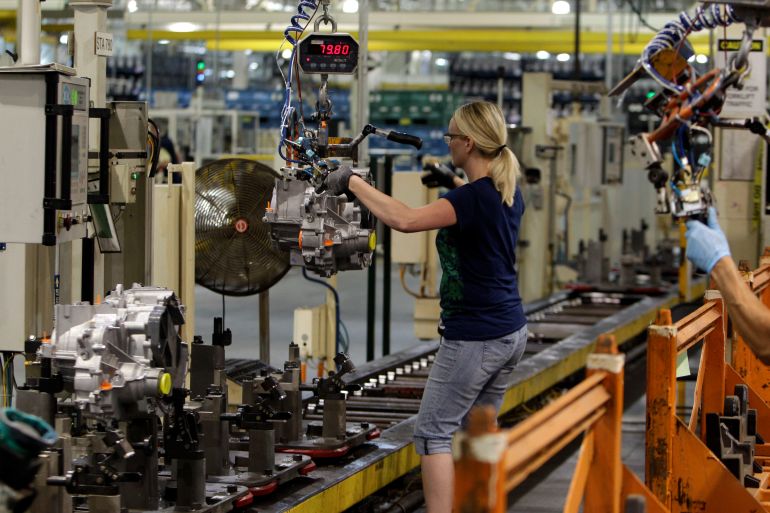As US aims to bring back manufacturing, supporting women is key
In Asia women factory workers powered manufacturing growth. Are there lessons there for the US?

Alicia Black’s four-year-old daughter, Rain, chats with her, trying to speak over the phone conversation her mother is also having. Black keeps up the two conversations while driving through rush hour traffic after working a shift at a factory in Milwaukee, where she makes lead acid batteries for cars and trucks and marine batteries for submarines.
Black sends her daughter to childcare three days a week because it is all she can afford. It has led to an intensely complex and fragile high-wire act to look after her daughter while keeping her job. While Black works day shifts, her husband works night shifts at the same factory. Her mother-in-law looks after their daughter on days when there is no childcare.
Black had to leave work during the pandemic when childcare centres and schools were shut and her daughter was home.
“I could not drop out. We need the salary,” she says of why she returned to work after spending nearly two years at home.
Supporting women workers, such as Black, is becoming a key piece of the challenge of bringing manufacturing back to the United States from China and other East Asian countries, where women factory workers have powered manufacturing growth.
On February 28, the Biden administration announced that computer chip manufacturers could avail themselves of billions of dollars in federal subsidies provided through the CHIPS Act if they provide childcare facilities at their factories.
During the pandemic, the Biden administration also provided the Child Tax Credit to support working parents, but the Build Back Better bill, which it was a part of, couldn’t pass in the Senate. Today, it is pushing for more measures to support women workers, but as it re-examines long-held practices and regulations that have held them back, the federal government encounters women’s challenging work lives, which have only gotten harder since the pandemic.
While in China, nearly half of all factory workers are women, in the US, women make up barely 30 percent of manufacturing workers. This number may have worsened, new studies have suggested.
A study of working parents with children under three years old showed that the number of those who quit their jobs had doubled in 2022, while those who were fired had tripled.
“While fathers reported taking a temporary hit, mothers reported taking a more long-term impact, such as quitting or being fired,” said Sandra Bishop, research director of the Council for a Strong America, an advocacy organisation that also did this study in 2018 to look at the effect of childcare on parents and the economy.
Part of the reason for this, as well as Black’s break from work, is that when childcare facilities closed during the pandemic, already low-paid childcare workers moved to higher-paying jobs, such as Amazon delivery or at Target stores. As many as 54,000 childcare workers have left the profession, according to research by the Center for the Study of Child Care Employment at the University of California at Berkeley. The resulting shortage left formerly working mothers unable to return to work.
At a Wisconsin factory that makes head gaskets and parts for electric vehicles, the hardships after the COVID lockdowns may have led female workers, like Brenda Scott who has been there for 20 years, to finally demand maternity leave and 40 hours a year of flextime to be with a sick child.
Scott worked while both her children were young, but she said things have gotten harder for younger mothers with childcare getting more expensive and scarce.
“I see so many children at home,” she said, as childcare gets increasingly out of reach.
Starting November last year through January earlier this year, workers from the United Electrical Radio and Machine Workers of America Union at Scott’s factory wore t-shirts, stickers and buttons and held posters as they worked on the shopfloor to make their needs clear to the management.
“The company should know we [working women] are united,” she said. “There has to be a way for a mother to be there for a sick child,” she said, rather than worry about losing her job.
The workers’ campaign led to two weeks of maternity leave being included in their work contracts for the first time.
“Two weeks is a bananas number,” said Suzanne Kahn, managing director of research and policy at the New York-based think tank, Roosevelt Institute. Besides longer leave, she said there was a need for measures that supported female workers who had left during the pandemic to find a path back into work as well as universal preschool and childcare.
While it is not enough, their campaign has left younger women workers at her factory excited, Scott said. They will continue to ask the company and policymakers to provide childcare, and up to six months of maternity leave. Foxconn, a Taiwanese subcontractor for Apple, is setting up a factory not far from Scott’s workplace in Wisconsin. She hoped that her union would be able to ask for similar contracts for women there, too.
However, those benefits may deter the companies that policymakers are trying to lure back to the US. Patrick Brown, a fellow at the Ethics and Public Policy Center, a conservative think tank said, “If the point is to get companies from Taiwan and Asia, if you attach so many strings, it won’t work.” Adding costs, such as childcare or additional leave, could send companies elsewhere, he said.
But Suzanne Kahn of the Roosevelt Institute said it might not be the low-paid, large-scale manufacturing jobs of the past that the US was seeking to attract. “I would think if we are working so hard to get these jobs, we would want good jobs.”
Lessons from the East
In China itself, where young women from rural villages filled factories, scholars point to the growing toll of an unrelenting work culture and an increased need for a supportive environment for women.
Young women from rural China relocated to work at factories, helping to produce at a large scale while keeping costs low.
Ariane Hegewisch, a senior research fellow at the Institute for Women’s Policy Research added that large-scale manufacturing “was built on a model of young women who would not have kids”.
Charlie Yi Zhang, associate professor in gender and women’s studies at the University of Kentucky, said he grew up in state-subsidised kindergartens while his parents worked in China.
“China and South East Asia reaped the benefits of low-cost, large-scale manufacturing that employed a lot of people,” said Charity Troyer Moore, scientific director for inclusion economics at Yale University’s Macmillan Center.
However, the childless model Hegewisch described has faded, with China ending its “one child” policy – allowing women to have three children, and Charlie Zhang added that, by the 1990s, the state-sponsored kindergartens of his youth were largely replaced by expensive, private facilities. The loss of state-sponsored childcare led to children being sent back to villages to be looked after by grandparents while mothers worked, or women putting off marriage and having children.
Rising costs of childcare have been among several factors that have led to a steep fall in women’s participation at work, as well as a shrinking population. Women’s participation in the Chinese workforce has fallen to 61 percent currently from 73 percent in the early 1990s, World Bank data show.
In Vietnam, where a large number of women work in garment and mobile phone manufacturing facilities, Hegewisch found that providing childcare at these factories helped with retaining employees and reduced work disruptions, although they kept the long work hours in place.
Retaining women workers
In the Midwest – to where the federal administration hopes to bring back manufacturing, retaining female workers could be a key part of having a trained workforce.
And yet, Alicia Black has often come close to leaving her job. She finally left when the pandemic struck.
After 17 years of working, childcare is “ridiculously expensive”, she says, and she can only afford three days per week.
When her daughter is ill, Black’s worries spike. Days off earn a point, and 12 points could lead to termination from work.
And it is not just Black. Women’s employment is five to eight times more likely to suffer due to caregiving responsibilities, a recent study by the think tank Center for American Progress showed. And while college-educated women returned to work at the same pre-pandemic rates, as many as 1.6 million fewer non-degree-holding women were working in January 2023 than from three years ago, according to the study. That number included women who work on shopfloors, in retail stores and restaurants, and other positions where degrees are not required.
“The manufacturing of the past is going,” said Yale’s Troyer Moor. “The manufacturing of the future … will have to be women-friendly.”
-al jazeera







